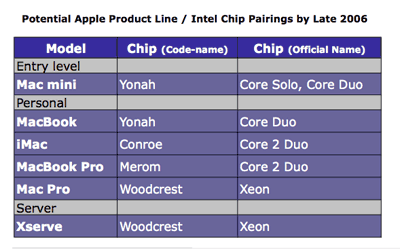Woodcrest to power Apple's next-gen Mac Pro desktops
Apple Computer has selected dual-core Xeon server processors from Intel Corp. to power its next wave of high-performance professional Mac Pro desktops, AppleInsider has confirmed.
Though the chips are almost architecturally identical to Intel's upcoming line of Core 2 Duo Extreme desktop processor (code-named "Conroe"), they differ in that they'll utilize the company's new Land Grid Array (LGA) 771 socket and also allow for multiple processor configurations.
Apple plans to take advantage of Woodcrest's multi-processor capabilities by offering versions of its upcoming Mac Pro professional desktops that will sport two of the dual core chips, people familiar with the Mac maker's plans have said. The new systems, which will succeed the Power Mac G5 at the forefront of the company's product matrix, will also be available in a single processor configuration for a substantially reduced cost, those people have since revealed.
Apple chief executive Steve Jobs is expected to showcase the new computers early next month as he demonstrates Mac OS X 10.5 "Leopard" — the company's next-generation operating system — during the annual Apple World Wide Developers Conference (WWDC) in San Francisco, Calif.
The new Mac Pro desktops will represent the last of the Cupertino, Calif.-based company's personal computer systems to transition from IBM's PowerPC-based processors to Intel's chips. And sources who have crossed paths with pre-production units claim they will rival, if not exceed in speed, the most powerful personal computer systems on the market today.
As Apple began development of the Mac Pro last October, it turned to Intel's Oregon division for the expertise in constructing a logicboard capable of housing a dual-processor Woodcrest configuration (or in other words, a graphics powerhouse sporting a total of four cores of processing power). Initially, it appeared that the two companies had aspirations of developing a radically compact board design, but they later settled on one approximately the same size as those found in Apple's current Power Mac G5 systems.
In addition to being the fastest of Intel's chips suited for a personal computer system, Woodcrest is also the first family of microprocessors to utilize Intel's "Core" microarchitecture. The architecture includes an advance cache technology that allows one core of a dual-core processor to use the entire memory reservoir while the other core is idle. It also supports a feature called "Smart Memory Access" that can hide memory latency and bottlenecks, as well as "Wide Dynamic Execution," which widens the execution core and allows for more instructions per cycle.
Apple's decision to base the Mac Pro on Woodcrest rather than Conroe may also help the company further diversify its four primary Mac product lines as the holiday shopping season rolls around — offering the potential for each line to differentiate itself from the others via a unique Intel chip variant.
Specifically, Apple may choose to updates its iMac consumer desktops with "Conroe" processors and its MacBook Pro professional notebooks with "Merom" chips, while continuing to build the consumer-oriented MacBook around "Yonah." Of course, Apple will also continue to offer its entry-level Mac mini desktop, which is currently available with either a dual-core and single-core "Yonah" chip.
Apple last updated its Pro desktop computers in October of 2005, when it introduced the Power Mac G5 Quad along with updated Power Mac G5 Dual models.
 Kasper Jade
Kasper Jade











 Andrew Orr
Andrew Orr
 Malcolm Owen
Malcolm Owen

 William Gallagher
William Gallagher

 Mike Wuerthele
Mike Wuerthele
 Christine McKee
Christine McKee








